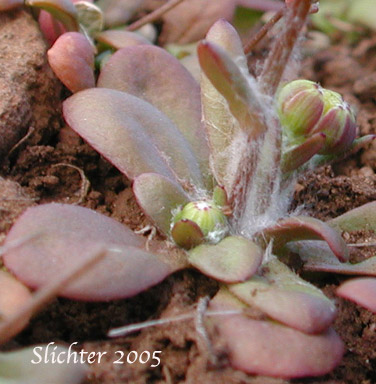 The
photo at right of shows the basal leaves and a flower bud of gold stars as seen
high atop the Columbia Hills to the north of The Dalles, OR............February
26, 2005.
The
photo at right of shows the basal leaves and a flower bud of gold stars as seen
high atop the Columbia Hills to the north of The Dalles, OR............February
26, 2005.
Gold stars are a small annual to 6 or 7 inches tall. The leaves are fleshy and mostly basal, entire margined to coarsely toothed, and spatulate in shape. The basal leaves are up to 2.5 cm long and 1 cm wide. The flower stem is single or occasionally branched into two or three stems at the base of the leaves. I've notice vigorously branched and almost bushy plants in areas burnt the previous year.
The flower heads are daisy-like, with 5-13 (usually 8) yellow rays 4-10 mm in length, and numerous yellow disk flowers. The disk is typically about 1 cm wide.
Gold stars bloom from late February into May, depending upon location and altitude. They do make attractive additions to naturalized, short grass meadows. A few nurseries and botanical gardens will occasionally offer them for sale. Buy them early to set in the ground so after they bloom, they will self seed. I have also collected seed in locations where they are abundant to sow in open areas in the rock garden.
Gold stars are found on moist banks and fields, sandy plains, and cliff ledges which dry during the summer.
Gold stars are found from Vancouver Island south through Puget Sound and west of the Cascades to northern California and southwestern Oregon.
In the Columbia River Gorge, it is found east of Crown Point between the elevations of 100'-3000' where it extends to the western base of the Blue Mts in Walla Walla County, WA and Umatilla County, OR.
It also extends northward up the Klickitat River canyon into the Yakima River basin into Kittitas County, WA, and southward to northern Deschutes County, OR.